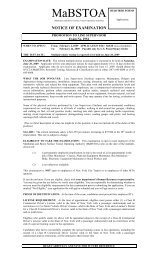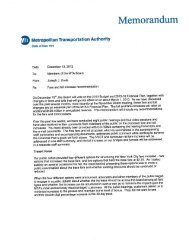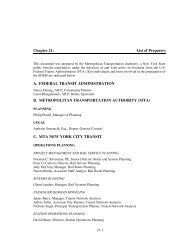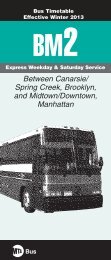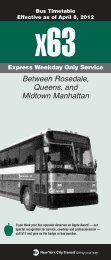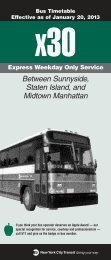Greening Mass Transit & Metro Regions: The Final Report - MTA
Greening Mass Transit & Metro Regions: The Final Report - MTA
Greening Mass Transit & Metro Regions: The Final Report - MTA
Create successful ePaper yourself
Turn your PDF publications into a flip-book with our unique Google optimized e-Paper software.
26<br />
Facilities<br />
Building and facility design, construction, operations, and maintenance<br />
Along with major fixed structures such as bridges, rail lines,<br />
and tunnels, the <strong>MTA</strong> maintains a highly diverse building<br />
portfolio of hundreds of facilities, including rail stations,<br />
subway stations, maintenance barns, office buildings, and<br />
such landmark properties as Grand Central Terminal. <strong>The</strong><br />
buildings represent a wide range of functions and styles.<br />
Many are open-air structures; some border wetlands, rivers,<br />
or parks; most date from the early 20th century; a number<br />
feature state-of-the-art designs; several occupy some of<br />
the most valuable real estate in the world. <strong>The</strong> <strong>MTA</strong> acts<br />
as both a builder and operator of its facilities. Both roles<br />
involve extensive management of energy systems, materials,<br />
and other aspects of sustainability. Because these holdings<br />
are so extensive, the <strong>MTA</strong> can make a significant contribution<br />
to regional sustainability through green building design<br />
and management.<br />
<strong>MTA</strong>’s Corona Maintenance Facility was North America’s<br />
and the <strong>MTA</strong>’s first LEED (Leadership in Energy and<br />
Environmental Design) certified transit facility. Based on<br />
this pioneering effort, the Commission has determined<br />
that LEED standards can apply to some transit facilities,<br />
and the Commission has recommended that in the future<br />
all applicable <strong>MTA</strong> projects seek a LEED Silver certification.<br />
However, the current LEED standards do not substantially<br />
apply to many typical transit facilities, such as power substations<br />
and most rail stations. With guidance from the<br />
Commission, the <strong>MTA</strong> is drafting the green building guidelines<br />
that will specify how these facility types can be designed<br />
in a sustainable way (see table later in this chapter).<br />
<strong>The</strong> <strong>MTA</strong> Green Building Guidelines will incorporate LEED<br />
criteria, as well as <strong>MTA</strong>-specific environmental criteria<br />
relating to noise and vibration, security, maintenance of<br />
transit operations, visual impact, and other transit-specific<br />
qualities. Once developed, these guidelines can serve as an<br />
industry model for green transit facilities and should be<br />
submitted to the U.S. Green Building Congress (USGBC)<br />
for potential adoption as a LEED for <strong>Transit</strong> standard.<br />
<strong>The</strong> other area where LEED standards may not apply to<br />
<strong>MTA</strong> facilities is in older structures. <strong>The</strong> <strong>MTA</strong> portfolio<br />
includes a large number of legacy structures from the<br />
early 20th century or before. While there are LEED standards<br />
for existing buildings (LEED-EB), only a minority of<br />
<strong>MTA</strong> structures can be readily adapted to meet them due<br />
to their specified functions. <strong>The</strong> <strong>MTA</strong> should seek LEED-EB<br />
certification for Grand Central Terminal, which would make<br />
it a national showcase for greening landmark buildings.<br />
For greening most of the <strong>MTA</strong>’s facilities, two ready options<br />
exist. Many of the more recent buildings should be recommissioned<br />
to optimize all energy systems. <strong>The</strong> <strong>MTA</strong> is<br />
identifying and assessing such structures. <strong>The</strong> remaining<br />
facilities should undergo rigorous energy auditing, as<br />
described in the Energy/Carbon chapter of this report.<br />
<strong>The</strong> Commission has urged the <strong>MTA</strong> to accelerate its<br />
building energy retrofits in conjunction with the NYPA,<br />
recommending that <strong>MTA</strong> set a goal of reevaluating the<br />
energy-efficiency potential of 100 percent of major <strong>MTA</strong><br />
facilities every 10 years. <strong>The</strong> retrofits entail ongoing green<br />
enhancements, such as high-efficiency lighting systems,<br />
boilers, and HVAC systems. In addition, the <strong>MTA</strong> has a<br />
number of green innovations for its existing facilities in<br />
various stages of planning, including high-performance<br />
roofs (vegetated “green” roofs, white roofs, and rainwaterretentive<br />
“blue” roofs) and other rainwater capture systems,<br />
solar panels, motion-activated escalators, groundwater thermal<br />
exchange systems, and more. Greener building maintenance<br />
should become standard operating procedure and would<br />
complement the initiatives described in the Energy/Carbon,<br />
Materials Flow, and Water Management chapters of this report.<br />
In light of the current financial climate, the Commission<br />
looked carefully at costs and potential savings in green<br />
building design. Its survey showed that LEED buildings<br />
can achieve operating cost savings as great as 9 percent<br />
annually, often enough to absorb their somewhat higher<br />
project contracting costs within a reasonable payback period.<br />
Upfront capital costs for LEED buildings can vary widely,<br />
depending on the project and the level of LEED attainment<br />
sought, according to King County <strong>Metro</strong> <strong>Transit</strong> in<br />
Washington State and Los Angeles County <strong>MTA</strong>, two<br />
transit agencies with experience building LEED facilities.<br />
<strong>The</strong>y estimate that it can cost little or nothing extra for<br />
projects to attain LEED certification and as much as 25 percent<br />
extra to attain LEED Platinum. Los Angeles <strong>MTA</strong> also<br />
found that some building projects could move up from LEED<br />
certified to a higher LEED rating at little or no added cost.<br />
To realize the full value of green design, the Commission<br />
has also recommended that the <strong>MTA</strong> adopt a Lifecycle<br />
Analysis (LCA) system for buildings, like the one described<br />
in the Materials Flow chapter of this report. Building design<br />
and maintenance can also benefit from the Sustainable<br />
Return on Investment (SROI) model presented in the<br />
<strong>Transit</strong>’s Triple Bottom Line chapter.





